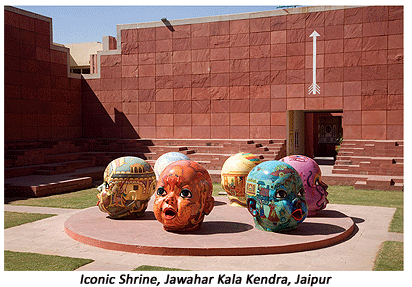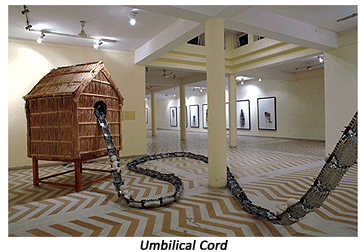- Prelude
- Editorial
- 'Public Sculptures are the Public's own Consciousness'
- Stimulating Thoughts
- Sculptural Traditions and Contemporary Art Practices
- Sculpting out a Third Dimension from Madhya Pradesh
- About Nostalgic Dragonflies and Homes in the Bags: Sculptural Snapshots from the North-East
- A Concise Chronicle of Bengal's Modern Sculpture
- Neo-sculptural Identity: Six Young Sculptors
- From Object to Experience: Notes on American Sculpture
- In the Domain of Drama Sculptures of S.Nandagopal
- Satish Gujral : Sculpting the Inner Form
- Transformation of Articulations: Mrinalini Mukherjee
- The Experiential Quotient in the Sculptures of Ravinder Reddy
- Shresta Rit Premnath A Passion for Structure
- The Anatomy of Melancholy: Sculptures of Rajesh P Subramanium
- A Crusader of/for Site Specific Public Art: Subodh Kerkar
- Installation Practices in and around Santiniketan
- A Wall is a Screen: A Promenade Film Street Performance
- Jaeger-LeCoultre An Overview
- Regency Style: Regency Furniture
- Designing the Streetscapes: Visual Elements of Pedestrian Corridors
- Sculpture Rules It All
- The Triumph of the Eternal
- Artist Index and Statistics- Anish Kapoor
- Auction Reports
- Musings from Chennai
- Art Bengaluru
- Art Events Kolkata: October-November 2010
- Mumbai Art Sighting
- An Evening of Interaction
- 6th Asian Museum Curators' Conference
- Swedish Art in India
- Couple of Difference : Recent sculptures of Karl Antao
- Previews
- In the News
- Sotheby's : Important Watches Geneva
ART news & views
Stimulating Thoughts
Volume: 3 Issue No: 11 Month: 12 Year: 2010
Pankaja JK in conversation with Chintan Upadhyay
 Disturbing Chintan Upadhyay in his busy schedule and ultimately getting an interview was a kind of annexing a difficult citadel. But here it was not my efforts but his kindness and friendly gesture helped me to get his interview for “Art : News & Views” magazine. This short and precise conversation shows his stronghold over his beliefs and sensitivity towards everything that he confronts in his life, be it human relation, technology or nature. The following conversation highlights it:
Disturbing Chintan Upadhyay in his busy schedule and ultimately getting an interview was a kind of annexing a difficult citadel. But here it was not my efforts but his kindness and friendly gesture helped me to get his interview for “Art : News & Views” magazine. This short and precise conversation shows his stronghold over his beliefs and sensitivity towards everything that he confronts in his life, be it human relation, technology or nature. The following conversation highlights it:
PK: As your name goes 'Chintan' you are really so concerned with the social causes. Are you 'an artist for social cause'?
CU: I would say that directly or indirectly every artist is in one way or the other related to social cause. They are concerned with the social issues. And even I feel sensitivity towards some issues and express my feelings against them in my art.
PK: Your creations, or say, installations are based on practical aspects of life rather than just giving an artistic pleasure. Do you enjoy this status of being a thoughtful artist and not purely an artist portraying romanticism with life?
CU: I am a thoughtful artist. People cannot say that an art is created purely for artistic pleasure. Art is not a creation in isolation, it has got some stimuli, some subject. So it extends beyond just artistic pleasure.
PK: Your 'Alec Babies' created wonder and stir in art world. How did this idea strike you and was there any particular reason to paint them with miniature paintings?
 CU: If you look at these babies you will find them homogeneous. So they represent homogeneous concerns. But the only thing that differentiates them is the Indian miniature paintings on them. Without these paintings they would be nowhere. In fact these paintings are their identity. I have chosen it deliberately. If we look at the modern trend of the world, we find everywhere in the world people are developing similar tastes in terms of clothing, food and lifestyle. There is a development of mall culture, famous brands which are widely available, so there is a kind of analogous behaviour throughout the world. So when one tries to move out of this identical zone, he searches for ethnicity. This ethnicity is an attraction. Alec babies portray this ethnicity, they stand out as Indian and therefore they stand out from others.
CU: If you look at these babies you will find them homogeneous. So they represent homogeneous concerns. But the only thing that differentiates them is the Indian miniature paintings on them. Without these paintings they would be nowhere. In fact these paintings are their identity. I have chosen it deliberately. If we look at the modern trend of the world, we find everywhere in the world people are developing similar tastes in terms of clothing, food and lifestyle. There is a development of mall culture, famous brands which are widely available, so there is a kind of analogous behaviour throughout the world. So when one tries to move out of this identical zone, he searches for ethnicity. This ethnicity is an attraction. Alec babies portray this ethnicity, they stand out as Indian and therefore they stand out from others.
PK: Your installations have been developed as factory products and also developed with the use of native skill. Do you find any difference between the use of technology and handcrafted installations?
CU: Technology works as a tool for me. I use it as a medium to develop my images. Traditional knowledge that I amalgamate provides me with information. They give me new ideas. But it is not always necessary that I adopt these ideas and work upon my original thoughts. But at times I do think over them.
PK: Were you always inclined to be an artist? Has any artist influenced you?
CU: No, I never wanted to be an artist. In fact, I wanted to be an architect. But I think being in any of these fields involves creativity. So my creative urges are satisfied as an artist. Speaking about influences, I have many. I cannot name anyone in particular. My influences range from people of art world to a layman. My thinking process is influenced by the situation around, the nature, the technology and almost everything.
PK: How do you analyse it?
CU: You see, everything around you is changing. Take an example of Bollywood; the outfits and the dance have got under western influence. After the Chinese product have taken hold over our market we find even a common man has started believing and getting attracted towards Feng Shui along with the Vastu Shastra. And all these things do influence my creative process. A man has to be thoughtful and when we start thinking, we start creating. Now we all know about Obama's visit to India, its purpose and its outcome. Still, as an artist I think over it. My thinking may be different from others, and in the same way hundred minds may think in hundred different ways. That's good for progress. And it is personally good for me as an artist, for it acts indirectly or unknowingly as a metaphor in my work.

PK: Can we have a peep in the lighter mood of Chintan Upadhyay? Do you remember any humorous moment in relation to your artistic progression which has made a mark on you?
CU: I love partying! I hail from Rajasthan which is a very colourful city, and so I love colors. The thing that I find very humorous is when people ask me to stop making 'babies'. People always look out for sensation and they have a kind of consumer mentality where they constantly look for 'latest' or change. They develop boredom when they see same thing for longer time. They expect me to give them some thing different from these Alec babies and that makes me laugh and feel sad towards their way of thinking. These Alec babies are not just products; they are the thoughts, expression and feelings. Don't have a surface view, understand the depth of it. Of course, I don't want to force anybody to admire it. But when they ask me to stop producing these babies I feel sorry for them. They seem to ironically conflict their own thought process. I doubt their admiration for art. Basically I am a provocative artist. I like to provoke people. If they show mediocre attitude and feel dejected if I do not stop producing these babies, then I think I have provoked them and by repeatedly boosting on stopping to produce them, they are provoking me. But my art is not based on someone's guidance about what I should be doing. It's totally my world and my creation…whether you like it or not…
PK: Your artistic journey is filled with social causes, awareness and rebellion against male chauvinism. Do you intend to write an autobiography in future?
CU: Oh! I am not a biography material. I cannot write about myself. Though I like to read autobiographies, I might not do justice while penning my life (smiles…signs off).